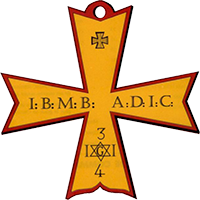
General Statutes of the Order of Strict Observance
Updated in July 699 by the Grand Master General of the Order and the Regent of the Rite, validated by the great provincial masters in operation.

Article I:
No one can be received in the Order if he does not believe in God, alone and in three people, and if he does not accept to defend fundamental Christian values.

Article II
In the tradition of the great orders of medieval chivalry, the Strict Templar Observance admits within it the Knight Ladies of the Order.

Article III
: Both nationally and internationally, the Strict Templar Observance is represented by its Grand Master General.

Article IV:
The nine Templar provinces of Strict Observance, which make up the Order of Strict Templar Observance, are headed by a provincial grandmaster, appointed by the Grand Master General.

Article V:
The nine Templar provinces of Strict Observance are:
1st province called Aragon
- 10 departments: 07-11-12-26-30-34-48-66-81-84
2nd province called Auvergne
- 16 departments: 01-03-15-19-23-38-39-42-43-58-63-69-71-73-74-87
3rd province called Occitanie
- 13 departments: 09-16-17-24-31-32-33-40-46-47-64-65-82
4th province called Leon
- 3 countries: Andorra – Spain – Portugal
5th province called Burgundy
- Switzerland and 15 departments: 08-10-21-25-51-52-54-55-57-67-68-70-88-89-90
6th province called Great Britain
- Belgium, Denmark, Finland, Ireland, Iceland, Norway, the Netherlands, the United Kingdom, Sweden and 35 departments: 02-14-18-22-27-28-29-35-36-37-41-44-45-49-50-53-56-59-60-61-62-72-75-76-77-78-79-80-85-86-91-92-93-94-95
7th province known as Lower Germany
- Germany (except Bavaria), Armenia, Belarus, Estonia, Georgia, Hungary, Latvia, Lithuania, Luxembourg, Moldova, Poland, Romania, Russia, Slovakia, Czech Republic and Ukraine.
8th province known as Upper Germany
- Albania, Austria, Bavaria, Bosnia, Bulgaria, Cyprus, Croatia, Greece, Israel, Italy, Lebanon, Lichtenstein, Macedonia, Malta, Montenegro, Monaco, San Marino, Serbia, Slovenia, Vatican and 7 departments: 2A-2B-04-05-06-13-83.
9th province known as archipelagos and islands below and beyond the seas.
- Currently Madagascar, Reunion

Article VI:
Each major provincial chapter, presided over by the Provincial Grand Master, is composed of nine dignitaries (all Knights Professed). The great provincial chapter governs and confers the ranks of the Inner Order: Scottish master, novice, temple knight, professed knight, as well as the additional ranks of Knight of the Sword or the East and Knight of the Eagle, Ruler of Rose-Cross.
Chapter composition:
- Provincial Grandmaster, Provincial Administrator,
- Grand Prior (prior and sub-prior of the clergy),
- Dean (and Attorney General of the province),
- Senior and Grand Marshal (and magister ritualium or master of ceremonies),
- General Visitor (and Commissioner of the Master Seat),
- Grand Chancellor,
- Grand treasurer (and magister oeconomiae or butler),
- Inspector of blue lodges or provisor domorum (and magister responsionum),
- Master of novices (dator pannorum).
The number of officers may be increased to seventeen members if necessary and within the limits of the above-mentioned offices.

Article VII:
The allegorical (symbolic) lodges are grouped into a large Scottish lodge, suffragizing directly from the great provincial chapter and under the authority of the provincial grandmaster.
Chapter Composition:
- Grand provincial master and administrator of the Order.
- Great Prior.
- A masterful vicar and grand chancellor of the Order.
- Lieutenant – Commander and Grand Treasurer of the Order.
- Dean and King-of-Arms of the Order.
- Senior and Grand Marshal of the Order.
- General Visitor of the Order
- Inspector of the Order’s blue lodges or provisordomorum.
- Master of the Order’s novices.

Article VIII
: Allegorical lodges practice the ranks of apprentice, companion and master.

Article IX:
The rituals used at all ranks are those written by Frederick – Auguste Mulda-er, under the control of Count von Brehl, a provincial visitor, and approved by the Kohlo convent of 1772; they must be clothed in the seal of the great chapter.
Any proposal to change the ritual must be subject to the approval of the Grand Master General who refers it with the very respectable brother regent of the rite, who alone has the power to approve or reject the said proposal.

Article X:
The Sisters and Brothers forbid any political and religious discussion in the lodge or chapter, as well as in any meeting of interest to the Order in general and in particular.

Article XI:
The Strict Templar Observance recognizes as equivalent all the ranks of the rectified Scottish regime and is entitled to practice any rank, system or rite related to its origin and history (especially the ranks of the Clermont system and those of the rite of Melesino) with the agreements of its great master general in activity and the regent of the rite.

Article XII
: As an Order, the Strict Templar Observance, in the interests of tolerance, today admits some courtesy visits to its lodges and chapters, (by symbolic equivalence of ranks), which share the same values, under the responsibility of the lodge master.
The Order of Strict Templar Observance allows its members to visit these obediences and Orders under the same conditions under the same conditions.
The discreet dual membership is allowed without any commitment or reference to the Templar Order.

Article XIII:
The Order is divided into three classes that are:
- The Templar cleric or very holy order.
- The Internal Order.
- Symbolic Freemasonry.
The great clerical chapter (proceeding from the top clerical chapter of the Templar Order) is, as we have seen above, presided over by the grand master general who confers the three degrees of the Templar cleric: postulant, novice, can
on.the grand master general presides over the high cleric who in no way has any equivalence of rank with any existing rite or regime. (Only a few great Willermozian teachers are discreetly admitted).
The Internal Order is presided over by the Grand Provincial Master.
The provincial chapter is composed of nine great dignitaries, it governs and confers the ranks of Scottish master, novice, temple knight and professed knight, as well as the additional ranks of knights of the sword or the east and knight of the rose-cross sovereign eagle.
The Great Scottish Lodge of Strict Observance groups the allegorical lodges and are grouped in the provinces each run by a provincial grandmaster.
These allegorical lodges practice the ranks of apprentice, companion, and master.
The officers in a dressing room are:
- The lodge master;
- The first supervisor;
- The second supervisor;
- The speaker;
- The secretary;
- The master of ceremonies;
- The chaplain;
- The hospital;
- The steward.
Each lodge can have its own internal rules; it must be in accordance with that of the province and targeted by its provincial grandmaster, who himself will have the provincial internal regulations in harmony with that of the Order and which will be targeted by the Grand Master General.

Article XI
V: The order’s fundamental texts are those adopted by strict Observance in the 18th century, namely:
- The rule of the poor knights of Jesus Christ and the Temple of Solomon, the so-called primitive rule of the Order of the Temple (1128), supplemented by the five articles in the rule transcribed in 1775 in Lyon (Willermoz funds).
- The statutes of the Illustrious Order of Strict Observance (1767).
- The statutes on the matter and how to remedy the trouble that may occur in the Order (1754)
- The statutes of the Brothers of the Temple concerning manners and conduct (1775), and all other founding texts bequeathed by our predecessors.

Article XV:
The Order of Strict Templar Observance has a charity of the Order and its great Scottish Lodge: The Opus Templi.
All hospitals of the fair and perfect lodges are asked once a year, in order to participate collectively in a charitable operation in France or in the world.
It is tradition to pay the Opus Templi the amount of the trunk of the alms obtained during the installation ceremonies of the lodge masters, masters of Ecossaise lodges and prefects.t
his work is managed by the great general mastery that informs the great provincial masters of the donations.

Article XVI:
A great dignitary or dignitary who has fulfilled his entire mandate, ascends to the honorary with the title of elder. Hierarchically it is located just after the one who wears the function. Example: Grand Provincial Master and then former Provincial Grandmaster.